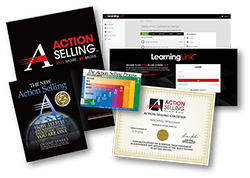
A WORD FROM DUANE SPARKS
Dear Sales Executive:
What is the weakest link in the capabilities of your sales force? What causes your reps to leave more money on the table than any other gap in their skill set? Most likely it’s their failure to cope effectively with stalls and objections.
Research by The Sales Board indicates that more than 90% of salespeople are ineffective at uncovering and then resolving objections. This is a huge problem. It persists despite the vast sums of money that companies spend on sales training.
If your sales reps keep failing despite all the methods you teach them for handling objections, maybe you’re teaching the wrong methods. In fact, I’m pretty sure of it. So, what is the right way to do it? Glad you asked.
If you have a question about how to make sales training pay off with spectacular results, click on “Ask The eCoach“.
We are committed to your professional success.
Duane Sparks
Author of Action Selling ®
NO DETOURS! WHY MUST YOU LEAVE THE SALES PATH JUST TO HANDLE AN OBJECTION?
 Every salesperson runs into stalls and objections from customers. Every sales-training company teaches methods for handling them. Yet despite all that training, when it comes to coping effectively with stalls and objections, our research shows that nine out of 10 sales reps stink.
There can be only one explanation: Most sales training teaches the wrong methods.
I believe there are three main reasons why sales training fails to make a significant difference in salespeople’s ability to handle stalls and objections. In the previous edition of eCoach, I explained the first reason: Almost all sales training treats stalls and objections as if they were the same problem, with the same solution. That’s dead wrong.
Here is the second reason: The objection-handling techniques taught by most sales training companies do not fit neatly and organically into the sales methodologies they teach. You’re following the path that’s supposed to lead to a sale, the customer stalls or objects to something, and, whoops! Off you go on some detour away from the sales path in order to deal with the objection. Good luck finding your way back.
It’s not as if stalls and objections are rare and exotic. They arise all the time. If training is supposedly grounded in a coherent sales system, shouldn’t you be able to stay within the system to handle a stall or objection? No detours!
Every salesperson runs into stalls and objections from customers. Every sales-training company teaches methods for handling them. Yet despite all that training, when it comes to coping effectively with stalls and objections, our research shows that nine out of 10 sales reps stink.
There can be only one explanation: Most sales training teaches the wrong methods.
I believe there are three main reasons why sales training fails to make a significant difference in salespeople’s ability to handle stalls and objections. In the previous edition of eCoach, I explained the first reason: Almost all sales training treats stalls and objections as if they were the same problem, with the same solution. That’s dead wrong.
Here is the second reason: The objection-handling techniques taught by most sales training companies do not fit neatly and organically into the sales methodologies they teach. You’re following the path that’s supposed to lead to a sale, the customer stalls or objects to something, and, whoops! Off you go on some detour away from the sales path in order to deal with the objection. Good luck finding your way back.
It’s not as if stalls and objections are rare and exotic. They arise all the time. If training is supposedly grounded in a coherent sales system, shouldn’t you be able to stay within the system to handle a stall or objection? No detours!
SHOULDN’T YOU BE ABLE TO STAY WITHIN THE SALES SYSTEM TO HANDLE A STALL OR OBJECTION?
Action Selling ® teaches that stalls and objections are different problems, requiring different solutions. But in both cases, the solutions allow you to remain within the 9-Act structure of the sales system. You may back up a little, but you never leave the clearly marked path that leads you toward gaining agreement from the customer. Is it a stall that arises in Act 7 when you ask for agreement? The customer is asking you to “sell me a little more.” So you do exactly that, using a method we call TFBR (for Tie-Back, Feature, Benefit, Reaction) that keeps you squarely within the system. Is it an objection instead of a stall? That means you didn’t ask all of the Best Questions in Act 3. So you simply back up to Act 3, ask more questions, then follow the path directly back to Act 7. No detours! Want a full, detailed explanation of the most successful ways to handle stalls and objections? Download our new White Paper. Objection! Is This the Salesperson’s Weakest Skill?ACTION SELLING IN ACTION
Handling stalls and objections becomes a whole new ball game for salespeople and customer-relationship professionals who are introduced to Action Selling ®. One reason the odds of success increase so dramatically is that you deal with stalls and objections without ever having to leave the sales system you’re working within. Action Selling ® client Alan Finkelstein, Director Global Learning, of pharmaceutical giant Merck, says that this feature has made all the difference. “If you do a good job with Act 3 and 4, it’s nearly impossible to hear an objection in Act 7,” Finkelstein says. “If one comes up, you missed something from the Best Questions Map. So you merely take a step back.” “If we hear a stall, we just reinforce what we presented as a solution from Acts 5 and 6. We present another capability, and we’re right back at Act 7 again.” “If we do these things well,” he continues, “the solution presentation is a winner. For example, suppose we hear an objection like: ‘We want to buy that drug in 100 ml vials. You only have 50 ml vials.’ The fact is, a safer or higher-quality drug will overcome a little inconvenience caused by smaller vials. But, unless you are able to identify (with your Act 3 questions) the problems the customer has had with things like safety or quality, little things like this can derail your sale.” For information about how to make sales training pay huge dividends, contact Action Selling ® at (800) 232-3485. Get a full explanation of why most sales training fails to cure problems with stalls and objections, and open your eyes to a better way. See our new White Paper. Objection! Is This the Salesperson’s Weakest Skill?Recent eCoaches
Don’t Look Now, But Your Sales Culture Gap is Growing
Close Your Culture Gap! Align Sales and Service
Why 64% of Salespeople Don’t Close
Stalls Vs. Objections: No, They Don’t Have the Same Solution
No Detours! Why Must You Leave the Sales Path Just to Handle an Objection?
I Object! (To the Way You Define Objections)
How to Train Your Way Out of a Sales Slump
It’s Not What You Sell, It’s How You Sell
How Do You Know If Your Sales Force Is Good?
“One Call” Close Not Dead Yet?
TQM for Sales Leadership? Yes!
Six Critical Processes for Sales Leaders
10 Great Ideas About Sales Leadership
The Three Core Roles of Every Sales Leader
The Nine Acts of Sales Leadership
5 Secrets to Record-Breaking Sales
Sales Training That Actually Works
The Sales Leader’s Toughest Challenge
How Strong is Your Sales Culture?
Want to Create the Best Sales Culture?


ASSESS YOUR SALES SKILLS
Unlock your hidden sales potential today – take our free Selling Skills Assessment.

THE NEW ACTION SELLING
A Quick Read That Will Boost Your Sales — Guaranteed!

